One thing that has bothered me about all of my experimentation with sous vide cooking is that everything that I’ve done could technically be done with normal cooking methods. Despite making the best chicken, steak, and poached eggs (or the only poached eggs) that I’ve ever made, it was possible for me to still cook this food with more conventional methods. I wanted something that is largely unachievable with any other method.
Enter the deep-fried porchetta, which I was inspired to make from this recipe
It pretty much captures what I love about sous vide — the ability to separate sterilizing food from creating the texture of food. Porchetta is hard because it’s difficult to fully cook the meat, keep the inside tender, and make the outside crispy (but not dry) all at the same time. That’s because there’s only one blunt object method of cooking it used (dry heat blasted outside in). Here, we can elegantly separate the parts (sterilization and tenderizing, vs. crisping… or deep-frying) by using separate cooking techniques, the key ones being sous vide and deep-frying. I couldn’t wait to try it.
Because this thing was going to need to run overnight, I didn’t want to chance burning down my apartment with my homemade sous vide machine. I figured I made enough food with sous vide that it would be worth it to finally spring for a real immersion circulator (Williams-Sonoma’s Sous Vide Professional, after deciding that it was too much trouble making sure used lab circulators on Ebay didn’t have deadly residue).
The recipe above calls for pork belly, but I didn’t want to do pork belly. I couldn’t find it at my local butcher (… Stop-and-Shop) and I make food to eat over many meals. Pork belly would be too rich and would become painful to continue eating relatively quickly (it’s quite far past the bliss point). Instead, I chose to go with 10lbs of skin-on pork shoulder, which I got tied and scored at Stop-and-Shop (it’s important to get it tied — refuse to get it scored if you must, but the thing will fall apart on you if you don’t have extra support from the ties). I figured it was a bit of a waste to go much smaller, since I’d still have the fixed cost of going through all the steps of making this thing regardless of how big it was. As it turns out, if I went smaller, I might have ended up with less oil burns and less stress trying to manhandle a massive hunk of hot pork, but hindsight is 20/20…
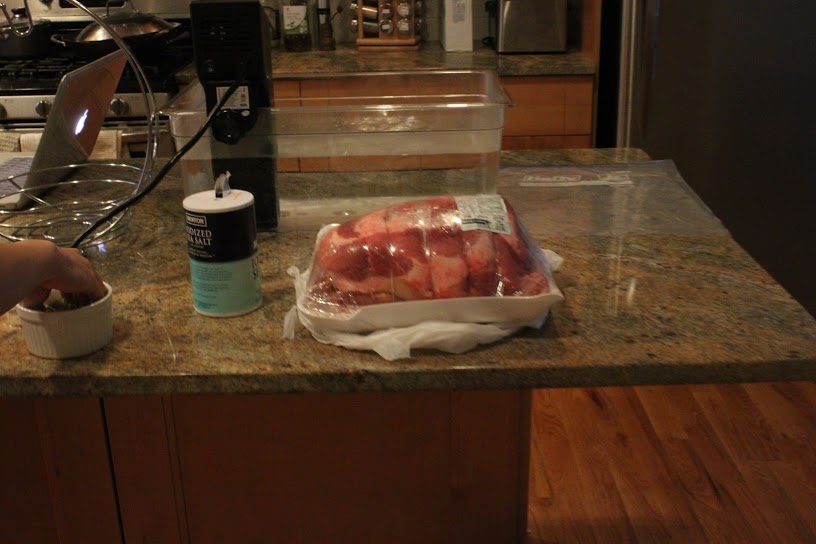 The pork shoulder fresh from the store. Looks far smaller at this distance than it feels trying to move it while hot.
The pork shoulder fresh from the store. Looks far smaller at this distance than it feels trying to move it while hot.After getting it back from the store, I prepared the spice blend I wanted to use (toasted fennel seed, black pepper, sage, rosemary, thyme, and crushed red pepper — I wanted to go with fennel pollen, but I took a look at the expense and decided maybe another time). The toasted fennel seed and black pepper mix gets pretty aromatic when you’re making it, which is great. Make sure you don’t use oil though, since it’s meant to toast dry. After toasting the seeds and peppers on the stove until deep brown, I blended them and coated them onto the shoulder, along with the other spices.
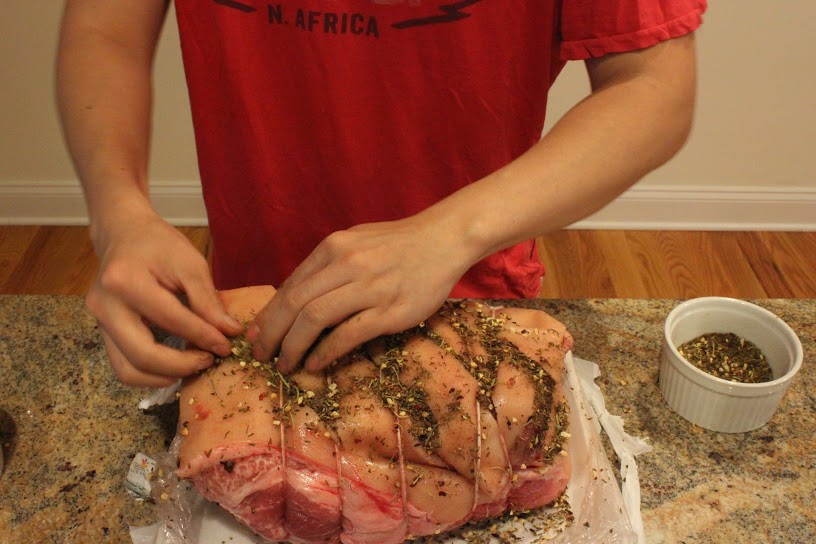 Adding spices. Make sure to get it into the crevices and into the butterfly cut (if you actually got it – I didn’t here because I wanted to just go with the pre-tied meat). It’s literally painful to tie your own meat if you’re bad at slipknots (like I am).
Adding spices. Make sure to get it into the crevices and into the butterfly cut (if you actually got it – I didn’t here because I wanted to just go with the pre-tied meat). It’s literally painful to tie your own meat if you’re bad at slipknots (like I am).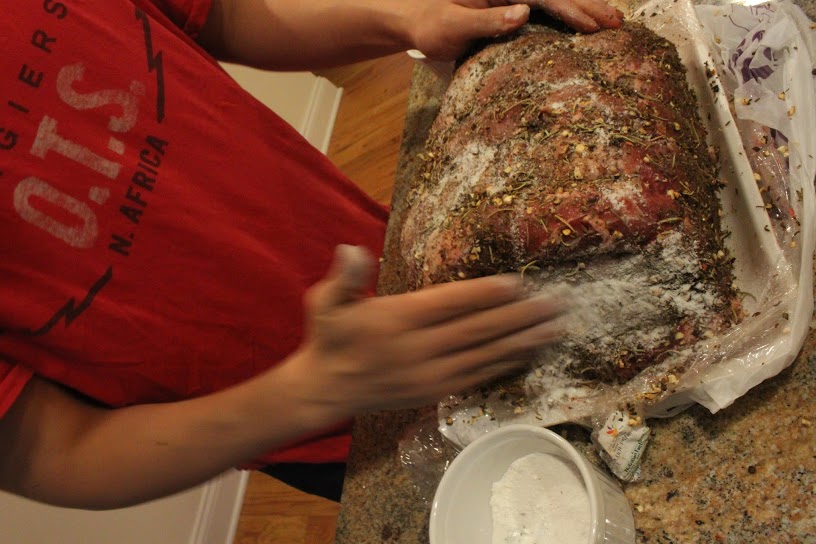 Salt is also important. Even if you’re worried about salt, most of it is going to “wash off” with the liquids that come out of the meat during cooking.
Salt is also important. Even if you’re worried about salt, most of it is going to “wash off” with the liquids that come out of the meat during cooking.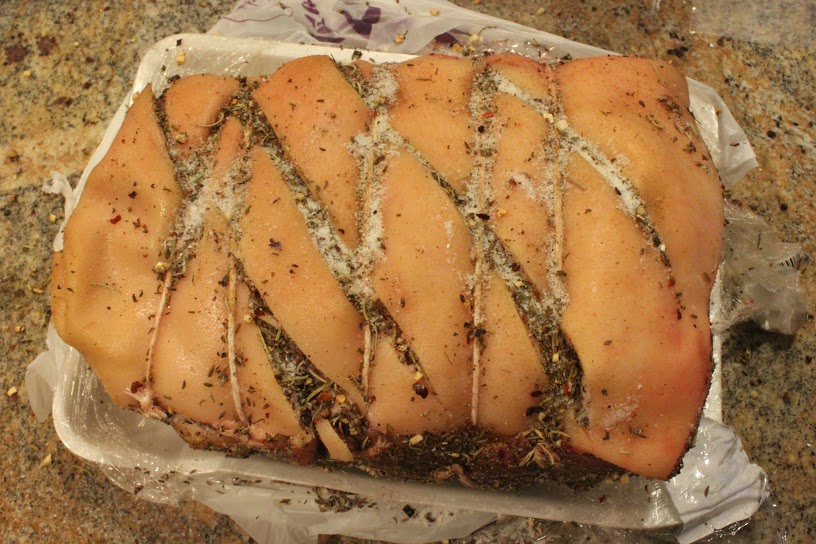 The finished product. Well, raw finished product.
The finished product. Well, raw finished product.After patting the meat down well with spices and salt, I just needed to load it into the sous vide and used a jumbo hefty bag (2.5 gallons) as my “vacuum bag.” It was far more painful than the picture suggests given the size of this thing and the logistics of trying to load a 10 pound pork shoulder with one hand and keep the bag open with the other. Additionally, the hefty bag leaks slightly, which was annoying for me and could be even more problematic for you if you chose to buy one of those potentially deadly immersion circulators from Ebay. Prior to this episode, I always used simple ziplock bags, which basically work as well as vacuum seal bags for most applications and can actually handle liquids (which get sucked out by normal vacuum sealers, unless you spring for a chamber vacuum). If you lower a ziplock bag into warm-to-hot water, the pressure from the water (more heat = more molecular movement/bouncing) pushes out the air.
After this episode, I’ve moved on to bulk vacuum seal bags (really big ones and 200 ft of them) bought from an online restaurant supply store to be used with a simple Foodsaver vacuum (which Liz got practically for free from a thrift store). But again, that’s not to say that the simple technique doesn’t work, which I want to emphasize because I’ve heard from some people that the cost of the equipment deters them from cooking sous vide. If it wasn’t for the fact that I’d make porchetta again and was able to obtain the necessary equipment on the cheap, I’d probably still be using ziplock bags.
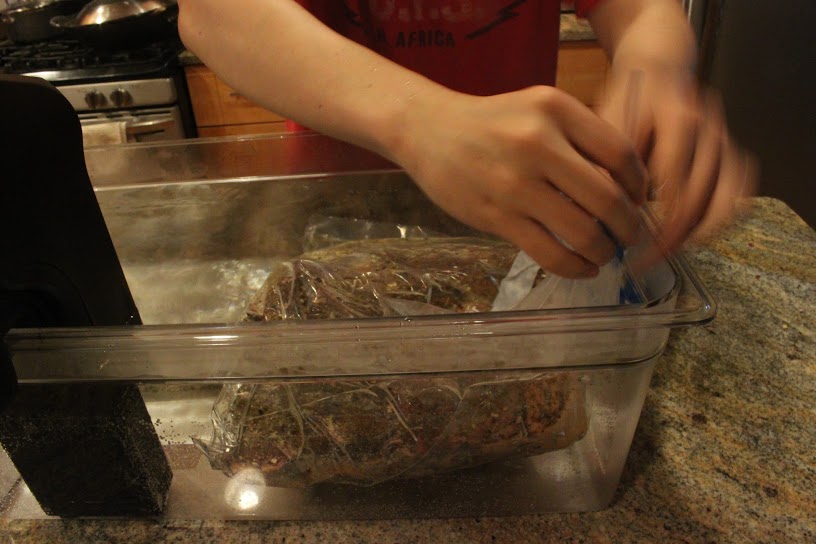 This looks far smoother than it actually went.
This looks far smoother than it actually went.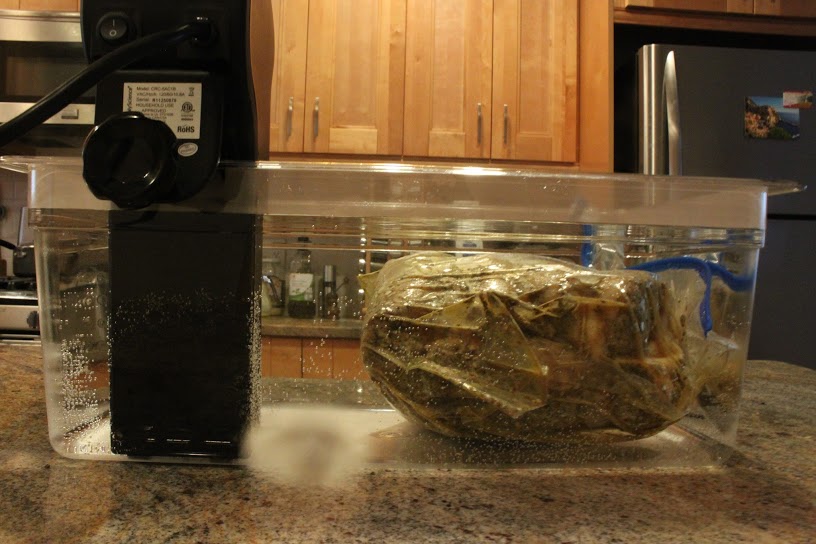 Looks tranquil in there.
Looks tranquil in there.The recipe calls for 155 degrees F for 36 hours but I didn’t want to wait that long. I squinted at bit at the pasteurization curves for meat and figured out that 165 degrees F for 24 hours would suffice instead to sterilize the pork. I expected that the temperature difference wouldn’t have much of an adverse effect on the texture either.
When 24 hours finally passed, it was time to deep fry. I went with the recipe’s suggestion to use a wok with oil (I used canola because of its high smoke point, relative healthiness, and price), since my thift-store deep-fryer isn’t big enough and while I was fine with sous vide cooking with it, I’m not confident enough in it to go high-temp with oil.
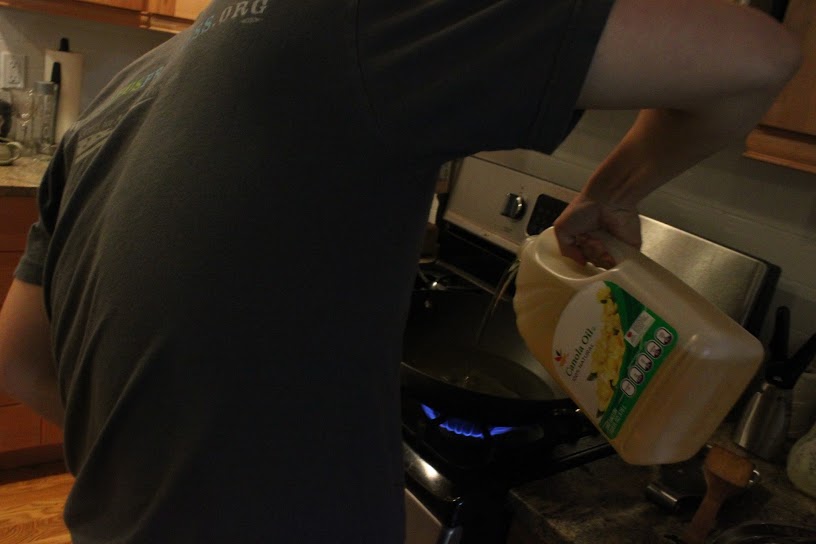 Pouring the canola oil. I suppose you can also call it a bit of inadvertent product placement for S&S.
Pouring the canola oil. I suppose you can also call it a bit of inadvertent product placement for S&S.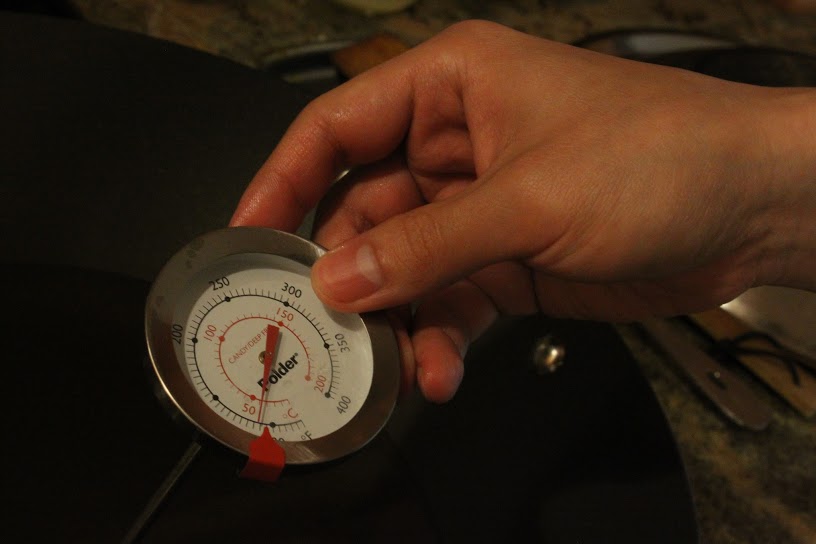 Looking for 300 to 350 degrees F. If you’re waiting for 400, you’ll blow past it since the temperature increase accelerates as you wait.
Looking for 300 to 350 degrees F. If you’re waiting for 400, you’ll blow past it since the temperature increase accelerates as you wait.Dropping the thing into the wok was somewhat painful. I think I need rubber gloves since although the shoulder was cooked at sub-boiling temperatures, it is still really hot for bare hands. I first poured off the juice/sauce/drippings into a bowl for gravy later and (for lack of better tools) grabbed the pork with my hands and manhandled it into the wok. It made a nice dual oil splash from the impact and the contact of residual moisture with the oil. I would suggest getting rubber gloves.
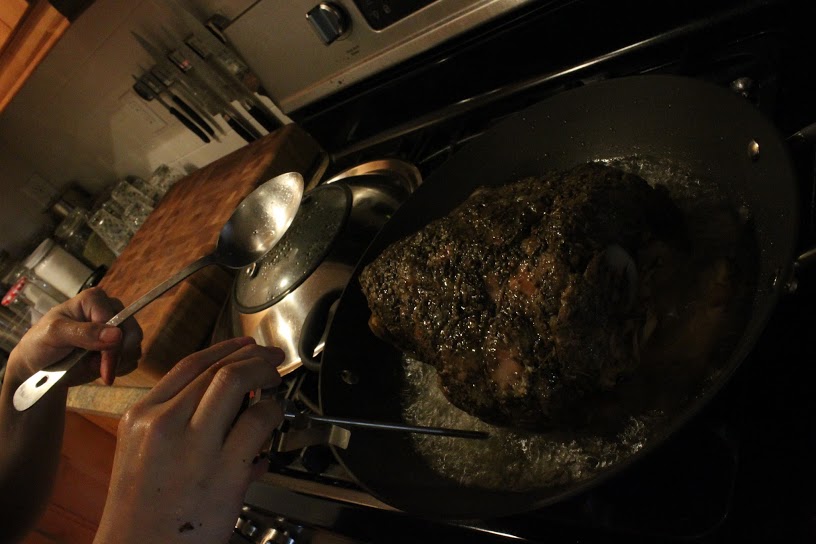 Splattering away. Holding the thermometer while ladling hot oil over the top of the porchetta, as per the recipe. Note that metal candy thermometers get hot as you hold it in boiling oil.
Splattering away. Holding the thermometer while ladling hot oil over the top of the porchetta, as per the recipe. Note that metal candy thermometers get hot as you hold it in boiling oil.Despite the pain, I’d say the end results were worth it. When it was done, this thing was tender enough that one of the bones slid out on its own accord. But that’s not even the best thing. Take a look at the skin.
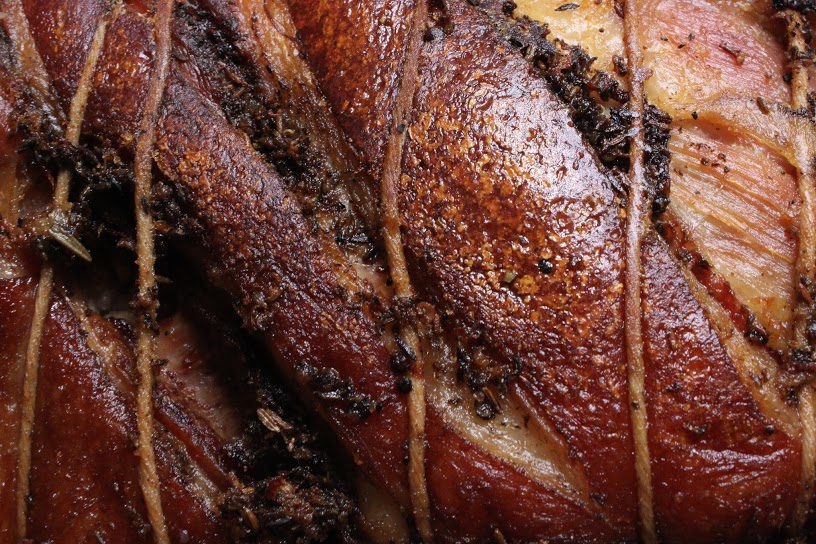 You can practically hear the crisp in this picture.
You can practically hear the crisp in this picture.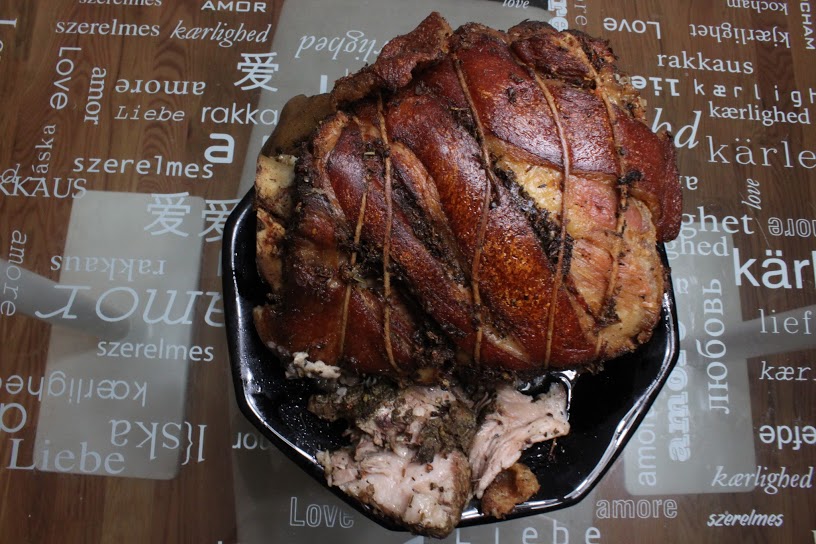 As delicious as it looks. The meat the bottom came out with the bone when it slid out of the porchetta.
As delicious as it looks. The meat the bottom came out with the bone when it slid out of the porchetta.This experiment was definitely worth it and I’ll be doing it again. The only problem is that it’s hard to eat much porchetta in one sitting, but I suppose that I did want to get a lot of meals out of it…